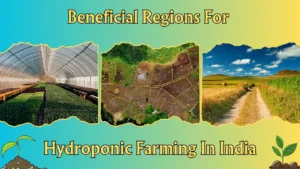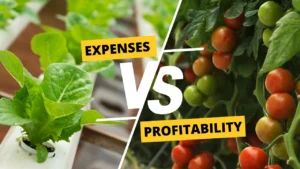Hydroponic Farming in India
With the industry reaching a market cap of $500 million, hydroponic farming in India is taking off! Many farmers throughout the country want to jump ship from traditional farming to this new-age method, where plants are grown without soil.
However, as a dedicated organic farmer in India with a decade of experience, let me tell you I have seen many “revolutionary” farming methods that replace the need for soil ultimately fail to reach profitability. The craze around vertical farming is a good example of that. While vertical farms deliver what they promise—clean, good produce—what good are those “leafy greens” if it won’t be able to keep the farm afloat?
This is why, my dear reader, I want to bring a new perspective to this conversation beyond the benefits of a hydroponic setup and look at the actual factors that will determine its expenses and, of course, its actual profitability.
If that interests you, join me in this deep dive of the actual business potential of hydroponic farming in India.
Understanding Hydroponics

Alright, let’s begin this dive by understanding the science behind hydroponics that gives such “potential” to revolutionize farming.
Hydroponics is a new-age method of cultivating plant roots not in soil, but suspended in a nutrient-rich liquid solution instead of soil. Additionally, to support optimal growth in hydroponic, many farmer use fertilizer such as calcium nitrate, though this is not the case with every farm.
In this system, the plants are grown in two main types: liquid and aggregate. The former grows roots directly in water, while the latter uses solid materials like clay pellets or rock wool to support the plants.
Example of Liquid Hydroponic System:
One good example of liquid hydroponic system is NFT or Nutrient Film Technique. A closed system in nature, In NFT, the farmer placed plants in a polyethylene tube that has slits cut in the plastic for the roots to be inserted. Solution is pumped through this tube and recovered to reused again.
Example of Aggregate Hydroponic System:
One good example of an aggregate hydroponic system is the Rock wool culture hydroponics in India. An open system in nature, it is probably most recognized in our country. Here, ground-up basalt rock is heated, then spun into threads, making wool. This wool is then used to ensure root growth; the plant is suspended in nutrient-rich water.
Beneficial Regions For Hydroponic Farming In India

Now that we understand what hydroponic farming is, dear reader, I think we are ready to ask an important question: is hydroponic farming in India better than organic farming, or, more specifically, are plants grown in such a system better than those grown in soil?
The answer is Not really! When it comes to physiological differences between plants grown hydroponically and those grown in soil, there isn’t much to write home about. In soil, matter decomposes into nutrients and gets absorbed by the plant as soil particles, and similarly, in hydroponics, the nutrients reach the roots just in a clean, water-rich solution instead.
So, why the hype? Well, while hydroponics may seem like just farming with an extra, expensive step, there are geological factors that make it a great investment for farming, in particular, hence its skyrocketing value across India.
Let’s go over them one by one.
Poor Soil Struggles
First and foremost are the places with completely unstable soil. This can be due to low soil fertility after extensive farming, or even man-made contamination. Enter hydroponics! For places where optimal growing conditions were nonexistent, hydroponics can help grow healthy crops efficiently with bigger yield of upto 30%.
Water-Scarce Zones
Across India, and particularly in regions near the Thar Desert, farmers can get a lot of value from hydroponic farming in India. Thanks to its characteristic of using significantly less water than traditional farming, while also having the ability to recirculate the nutrient solution and reduce water waste, hydroponics is a great way to fill the gaps where traditional irrigation has fallen short.
Rugged Terrain Challenges
30% of the region in India is mountainous in nature. In this rocky and uneven terrain, farmers often struggle to farm efficiently due to the impractical nature of the land. While terrace farming is, of course, a preferred choice in these places, hydroponics, with its better controlled nature, is slowly catching on to fulfill the needs of farmers.
Hydroponic Farming in India: Expenses vs Profitability

Alright, it’s time we get to the promised subject of hydroponic actual potential as a business.
While there is a Compound Annual Growth Rate (CAGR) of 13.53% from 2020 to 2027 for the industry, this is due to the ever-increasing shift in consumer preferences toward organic produce, especially in metropolitan and Tier 1 cities. However, the regions that are driving the adoption of hydroponic farming in India are actually based mostly in rural and urban India, and they are fulfilling the needs of their local market first. The reason for this, as I stated above, is the value it brings to land where traditional farming faces limitations.
Now that we understand this insight, we can use it to investigate and make an educated guess about both the expenses for hydroponic setup and its profitability if the farm is successful in reaching Tier 1 cities.
Expenses: Cost of Setting Up a Hydroponic Farm in India
Let’s start with expenses.
Setup Costs
Given adoption is happening in rural or urban farmland, the cost of 1 acre hydroponic farm in India can vary significantly based on what type of system the farmer chooses. Deep water culture, rock wool culture, nutrient film, and even aeroponics are all different subsystems that need constant maintenance.
That means a farmer has to invest not only in resources for plants, but also in a high-tech sensor-powered monitoring system, a green house, or climate control systems, with ample safety that could cost ₹8 lakh to ₹10 lakh itself.
Of course, the price can fluctuate depending on the state in India where you are setting up the hydroponic system, as there are various levels of government support for innovative farming efforts, but still, you have to be ready to find and invest in a proper autonomous system for the farm yourself.
Operational Costs and Labor Cost
When it comes to maintenance, whether daily, weekly, or monthly, while hydroponic systems use up to 90% less water than conventional farming, the cost of nutrient solutions still needs to be considered. The actual cost of this liquid solution depends on its quality, but the biggest factor for maintenance will be the location in which you are setting up the farm. According to some sources, the nutrient solution for hydroponics in India can cost upto 20k per acre annually.
Similarly, there is a monthly cost that has to be paid to both the skilled labor and the workers, as well as the monitoring team that will be responsible for the upkeep of the tech and autonomous system. Once again, hydroponic systems are fragile in nature and at risk of becoming contaminated from a single mistake. Given all this, the cost could be as low as 25k to 1 lakh per month.
Profitability: Is Hydroponic Farming Profitable in India?
So, with the factors above in mind, is hydroponic farming profitable in India? The answer is yes! It is quite profitable once you scale it.
Recovery Period and Yield
Investments recover within a reasonable time frame of 18 months to 2 years. the reason behind this recovery speed? The high yields farmers get!. While it’s not for every type of crop, when it comes to leafy greens, it can yield up to 20-30 times more than traditional soil farming.
Let’s assume a conservative number of 15 tons.
Market Price and Profit

The price of vegetables grown hydroponically can be premium because of their perceived freshness and quality. Leafy greens such as spinach, cabbage etc. Can be sold between ₹52 to ₹110 per kilogram, based on the region and market.
This means the total revenue from selling 15 tons could vary between approximately ₹7.8 lakh and ₹16.5 lakh.
Which in turn means even sell at an average price, the farmer can cover the initial setup costs of the hydroponic farm within just 12 months, making the business sustainable.
Advantages of Hydroponic farming in India
Alright, now that we’ve covered everything, let’s summarize the advantages of hydroponic farming for both individuals and the regions in which it is used.
- Hydroponics does not need weeding or cultivation control.
- Hydroponics delivers much higher crop yields, all organic and without pesticides.
- Hydroponics helps the farmer gain better control of growing conditions and the environment, with a focus on controlling pH and nutrient content.
- Hydroponics completely removes soil from the picture, along with all the traditional issues.
- Hydroponics is the perfect solution for rocky regions where traditional farming does not work.
- Hydroponics is also the perfect solution for places that have completely lost soil fertility in their land.
- Hydroponics, contrary to popular belief, does not require less water than traditional farming.
Final Thought
Well, there you go! Hopefully, armed with the knowledge above, you were able to grasp how much potential the industry for hydroponic farming in India actually holds.
If you are thinking of investing in hydroponics, I recommend you do so only if you can ensure not just capital, but proper technological maintenance, for maintaining its nature, as it is easily contaminated, whether by pests, nature, or man-made factors.
While I like to stick to being an organic farmer, there are many talented farmers that are taking up hydroponic farming. Given the projected compound annual growth rate (CAGR) of 13.53%, this method will continue to gain traction as consumer demand for fresh, organic produce skyrockets.



